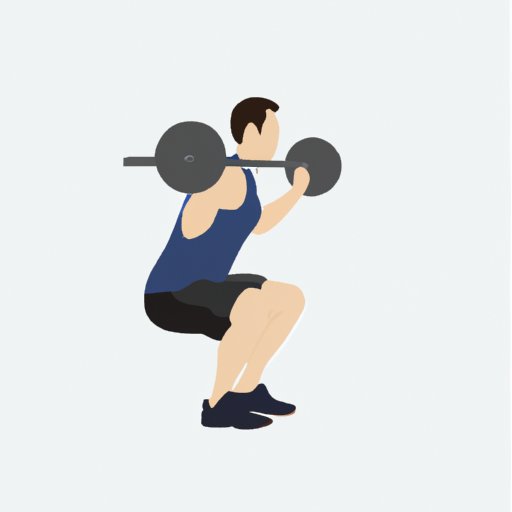Introduction
Are you looking for an exercise that targets multiple muscle groups, improves overall fitness, and boosts athletic performance? Look no further than the humble squat! This exercise is easy to do, can be modified for different fitness levels and goals, and yields numerous benefits. In this article, we will cover the step-by-step process of doing squats with proper form and technique, offer safety tips, explain various benefits, and provide information on different squat variations you can try.
Step-by-Step Tutorial
The proper form and technique for doing squats are crucial for avoiding injury and maximizing results. Follow these steps:
- Stand with your feet shoulder-width apart and your toes pointing forward.
- Bend your knees, keeping your back straight and your weight on your heels.
- Lower your body until your thighs are parallel to the ground.
- Press through your heels to stand back up.
- Repeat for the desired number of repetitions.
Common mistakes to avoid include:
- Letting your knees buckle inward.
- Arching your back or leaning too far forward.
- Not lowering your body enough.
To avoid these mistakes, keep your knees in line with your toes, engage your core muscles, and make sure your thighs are parallel to the ground. If you are having trouble, start with bodyweight squats and gradually build up to using weights.
Remember to warm up before doing squats and stretch afterwards. Take breaks if you need to, and stay hydrated throughout the exercise.
Video Tutorial
To further illustrate proper form and technique, here’s a video tutorial:
Benefits of Squats
So, what are the benefits of doing squats? Here’s a rundown:
- Builds muscle mass: Squats target multiple muscle groups, including quadriceps, hamstrings, glutes, and calves, making them a great exercise for building muscle mass and strength.
- Increases athletic performance: Squats have been shown to improve performance in other physical activities, such as running and jumping.
- Improves balance and posture: By strengthening core and leg muscles, squats can help improve your balance and posture.
- Burns calories: Because squats engage so many muscles, they are a great form of cardio and can help you burn calories and lose weight.
- Boosts overall health: Squats have been shown to improve bone density, reduce the risk of injury, and promote overall health and fitness.
These benefits are supported by research. For example, a study published in the Journal of Strength and Conditioning Research found that adding squats to a training program improved athletic performance among male soccer players.
Proper Form and Technique
Here are some more tips for maintaining proper form and technique when doing squats:
- Keep your chest lifted and your eyes forward.
- Engage your core muscles throughout the exercise.
- Don’t lock your knees at the top of the movement.
- Exhale as you press through your heels to stand up.
Remember to start with bodyweight squats and work your way up to using weights. And if you feel any pain or discomfort, stop immediately and consult a healthcare professional.
Squat Variations
Looking to mix up your squats routine? Here are a few variations to try:
- Sumo squats: Stand with your feet wider than shoulder-width apart and your toes pointing out. Lower your body as you would for a regular squat.
- Single-leg squats: Stand on one leg with the other leg extended in front of you. Lower your body as you would for a regular squat, then switch legs.
- Frog squats: Squat down with your feet together and your knees pointing out. This variation targets your inner thigh muscles.
For each variation, make sure to maintain proper form and technique. And remember to start with bodyweight versions before adding weights.
Squats with Weights
Adding weights to your squats can increase resistance and challenge your muscles even more. Here’s how to do it:
- Choose an appropriate weight, such as dumbbells or a barbell.
- Hold the weights at your sides or on your shoulders, depending on the type of weight you’re using.
- As you lower your body, keep the weights close to your body and your back straight.
- Gradually increase the weight as you get stronger.
Remember to use proper form at all times and to start with lighter weights and gradually increase the resistance over time.
Conclusion
Squats are a versatile, effective, and safe exercise that can benefit anyone looking to improve their fitness and build muscle mass. By following the proper form and technique, avoiding common mistakes, and using variations and weights as appropriate, you can incorporate squats into your workout routine with confidence. Remember to warm up, stretch, and stay hydrated throughout the exercise, and don’t hesitate to consult a professional if you experience any pain or discomfort.
Additional resources for learning about squats and strength training include personal trainers, fitness classes, and online tutorials.
